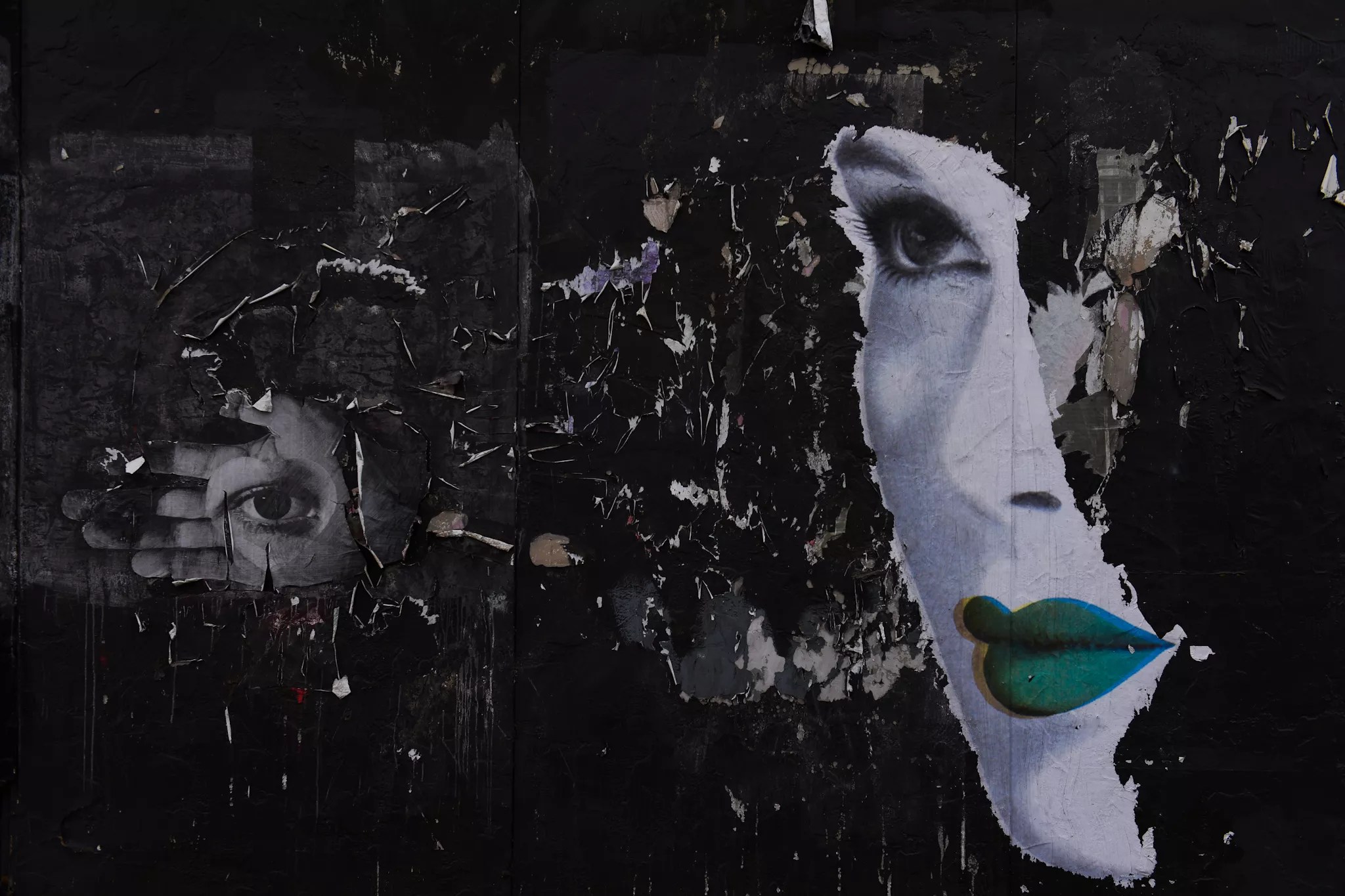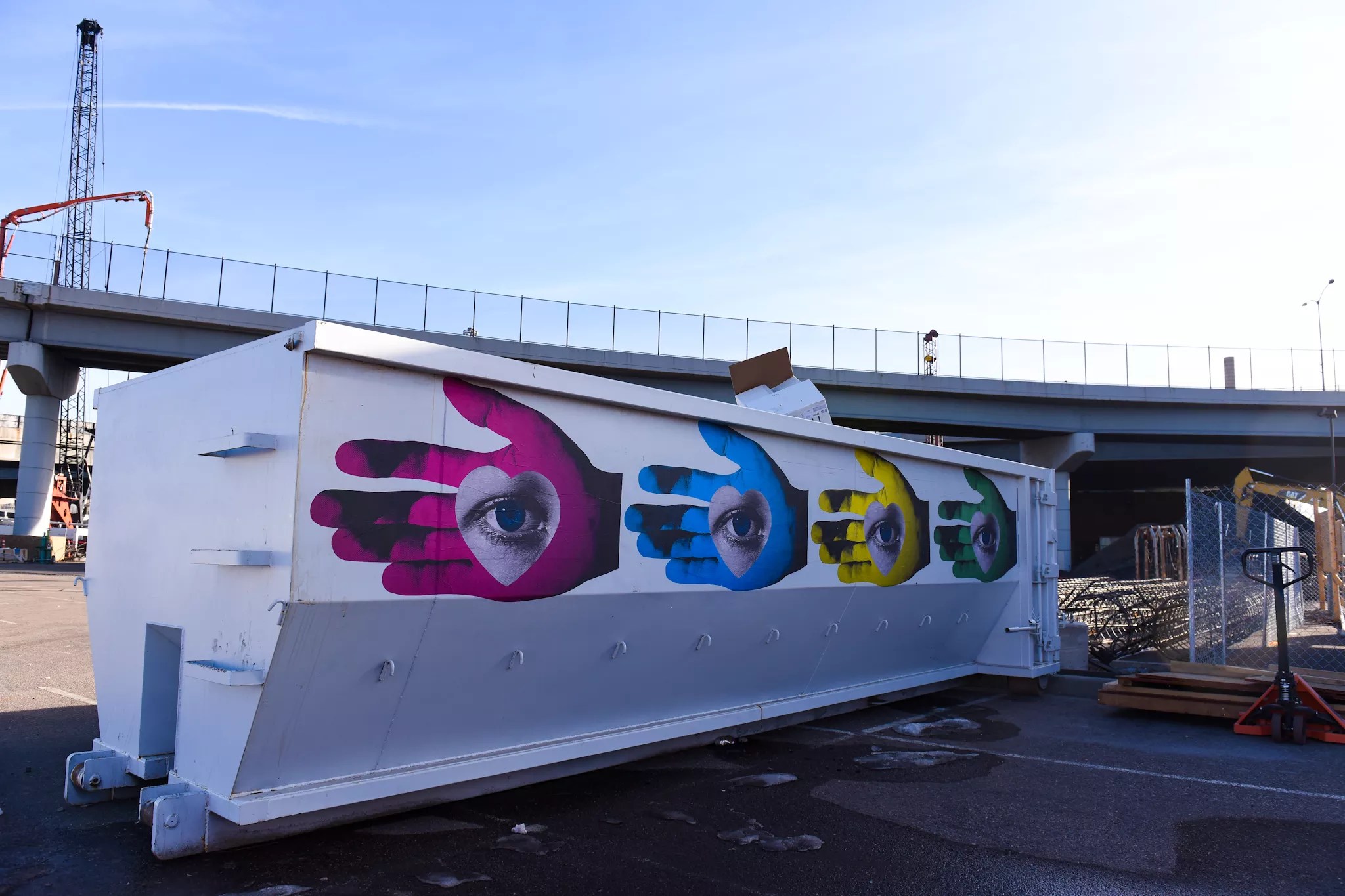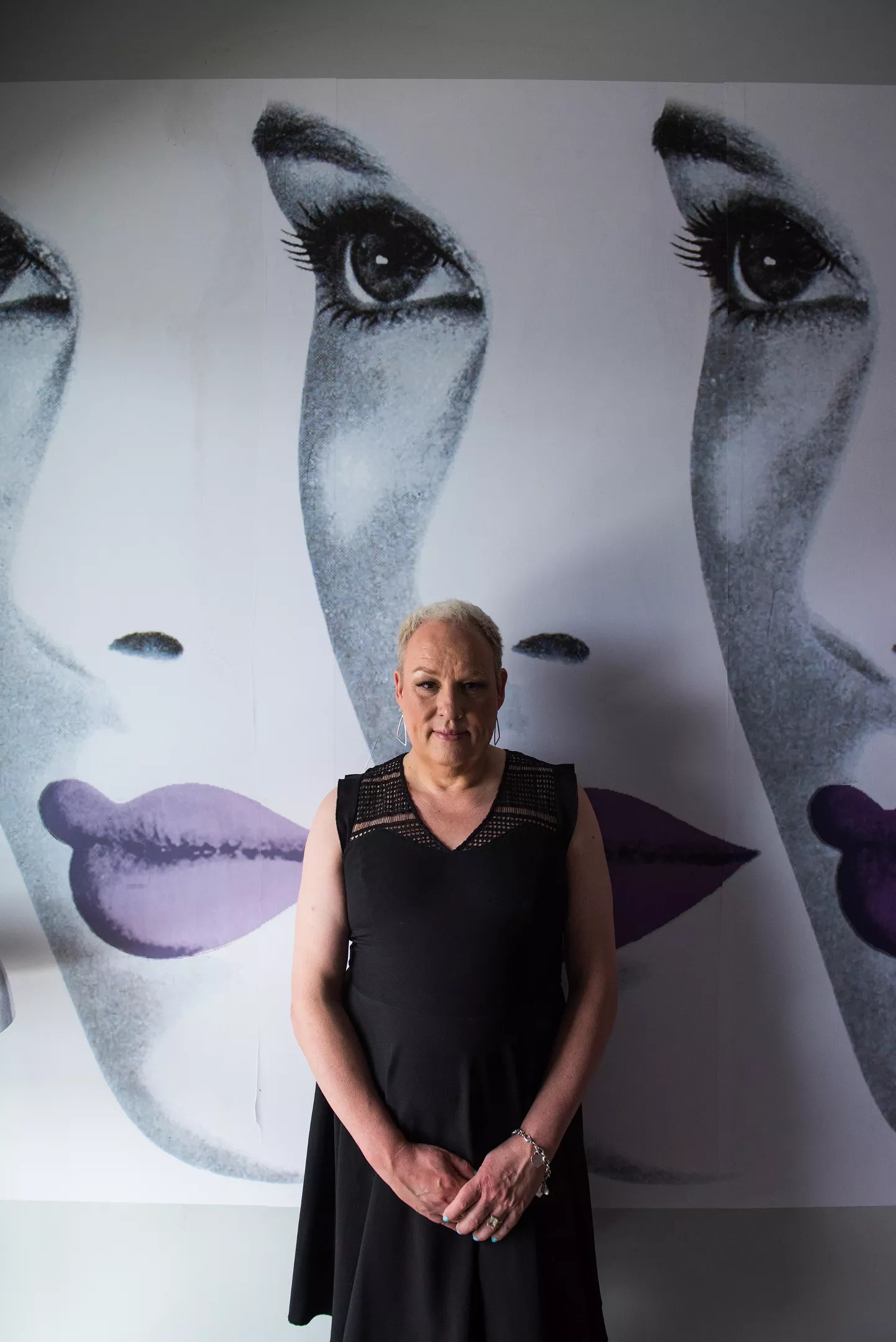
Kenzie Bruce

Audio By Carbonatix
Koko Bayer keeps her wheat-paste gear in the back of her soft-cover Jeep, which is still without windows in February. Blek the rat, a Beanie Baby-like stuffed mouse named for the French street artist considered the father of stencil graffiti, sits on the Jeep’s spare tire. Bayer’s brushes and gloves are in the back seat in a Trader Joe’s freezer bag, the best art bag she’s found, along with a bright-pink hard hat and a bucket adorned with stickers of Bayer’s trademark image: a black-and-white eye with a blue pupil inside a pink hand.
The artist started adorning Denver’s walls in 2015 – shortly after she established herself as Koko Bayer. A transgender woman, she was born in France and raised as a male. Her chosen name is closely tied to her art, which combines graphic design and wheat-pastes with images, like the eye inside the hand, inspired by the work of Herbert Bayer. Although she was already eighteen when her mother married Javan Bayer, Herbert’s son, her new grandfather proved a major influence.
“Familiarity can breed contempt, you know,” Koko Bayer says, “but when I went to art school and started in graphic design, I started connecting to his work. Since then, I’ve looked to his work to help me solve my problems.”

Herbert Bayer in front of the Sgraffito Mural at the Koch Seminar Building at the Aspen Institute, which he designed.
Photo courtesy of Denver Public Library’s Western History Library
Will you step up to support Westword this year?
At Westword, we’re small and scrappy — and we make the most of every dollar from our supporters. Right now, we’re $23,000 away from reaching our December 31 goal of $50,000. If you’ve ever learned something new, stayed informed, or felt more connected because of Westword, now’s the time to give back.
Herbert Bayer was born in Austria in 1900 and attended the Bauhaus, the legendary German art and design school that opened a hundred years ago this year, and from the start struggled against reactionary forces fighting modern art. Bayer moved quickly from student to teacher, then left the school in 1928 to pursue advertising work in Berlin; he became an art director at Vogue‘s German office.
The Nazis closed the Bauhaus in 1933, and in 1937, Adolf Hitler dedicated the Great German Art Exhibition in Munich. The next day, the Nazis opened the Degenerate Art Exhibition, attacking anything modern, abstract or non-representational. Herbert Bayer’s work was included in that show. “They hated everything modern and linked it to Jews, intellectuals and Communists,” his granddaughter says. “Herbert wasn’t political, and he was doing so much work in the 1930s, and you can see it physically get darker.”
The next year, Bayer left Germany, landing first in Italy, then New York. In 1946, in a move his granddaughter says was “risky, career-wise,” he relocated to Aspen, where he helped design the Aspen Institute and numerous promotional posters for the ski industry. He also created his “Articulated Wall” sculpture, which was installed off South Broadway in Denver in 1985, the year he died.
Koko Bayer’s mother and stepfather took over Herbert Bayer’s Aspen studio. “Even before my mother married Javan, I had been around Herbert before. He was this enigma to everyone,” she remembers. “After he died, we all talked about him like he was in the other room.”

Koko Bayer is working on an ongoing installation at the Meow Wolf construction site in Denver.
Kenzie Bruce
Koko Bayer began her own art career experimenting with different art forms: film, graphic design and photography. For years she photographed jazz musicians – her first name comes from the Charlie Parker song “Ko Ko.” But while she enjoyed photography, she wasn’t sure that’s what she really wanted to do. “It makes you crazy, being an inauthentic version of yourself and being who you think society wants you to be,” Bayer says.
Now when she does photography, it’s either a job for Tracks (one of her primary clients) or photographing her wheat-pastes that have appeared all over town. Her murals have, too: She’s a regular at Crush Walls, and her designs not only cover the walls of the RiNo Art District office at Zeppelin Station, but they’re on the front of the RiNo Art District 2018 Field Guide, too.
Bayer estimates that she goes through two gallons of paste every couple of days, and notes that it’s often cheaper to buy a dry, commercial paste than make her own. “Winter is challenging for wheat-pasting,” she says. “If it’s below 40 degrees, it’s not happening.”

A collaboration between Koko Bayer and Chris Haven from summer 2018.
Kenzie Bruce
For small projects, Bayer uses local printers owned by Denver artists, mostly Primerdome; for commercial work, she prints at ARC. She enjoys working with other artists, she says, even as they compete for blank canvases on the street. “Denver’s gotten so tight with uncontrolled spaces. But I do love the collaborative spirit; in the traditional art world, that’s not there,” she says, adding that she particularly enjoys collaborating with friends like Chris Haven and his Secret Skwadron.
“There’s a culture of respect with wheat-pasting,” she says.
Other Denver wheat-pasters, including Risa Friedman and Meredith Feniak of We Were Wild, have looked to Bayer for inspiration. “We contacted her when were first starting,” Friedman says. “We could listen to her talk for hours.”
“She was so sweet; we had really no idea [what we were doing], to the point that she took us back to her Jeep and pulled her bucket out of her car and was like, ‘This is the bucket I use, this is the brush I use, here’s a grate that you can put in the bucket to leave the roller in the grate,”’ Feniak says, and laughs. Both Friedman and Feniak marvel at that Trader Joe’s freezer bag that she uses to tote her supplies. “She just walks away, and it looks like she’s not wheat-pasting or anything! Genius,” Feniak points out.
Even Meow Wolf has had its eye on Bayer; she’s currently working on a project for the Santa Fe-based immersive-arts organization, decorating the dumpsters at the site where Meow Wolf Denver will one day rise. “How often does that happen?” she asks. “Usually when you’re getting a call from someone about something on dumpsters, you’re like, ‘Oh, shit.’ It happened so organically. I find that everything good in my life happens that way. The more pressure you put on things to happen, the least likely they are to happen. I’ve been trying to embrace that the last few years, and it’s worked out for me. I’ll put myself in positions where things can happen, but I can’t force it.”

A dumpster at the Meow Wolf Denver construction site. The art collective reached out to Koko Bayer to decorate the site.
Kenzie Bruce
The artist has used her Instagram account to share photos of her work and connect with other wheat-paste artists around the world. “I was lucky to grow up in an environment where being an artist was a viable career,” she says.
While Bayer has advocated for her grandfather’s work, she hasn’t done much trans advocacy work.
Bayer “came out of the closet” 25 years ago, she says, but didn’t fully transition until about eight years ago. She met her wife, Sara, in 2010, and has two teenage stepchildren. “Tolerance is one of the more offensive concepts,” she muses. “You tolerate pain. You tolerate the weather.”
You do not tolerate intolerance.
During the 2016 elections, Bayer was deep into researching 1930s Germany for a documentary about her grandfather called head + heart + hand, and noted terrifying similarities between pre-World War II nationalism and the rise of leaders using nationalistic rhetoric around the world, specifically the United States. “It’s Dictatorship 101,” she says.
After Donald Trump was elected, Bayer wheat-pasted Shepard Fairey’s “We the People” posters around Denver. “It was great to have wheat-paste to express dissent,” she says. “For the trans and gay community, we knew that was taking a huge step backwards. … It felt good to do something positive – but challenging – and to use my tools.” Bayer got to thank Fairey in person at Crush Walls last year.

Koko Bayer in her Denver home.
Kenzie Bruce
For one of Bayer’s upcoming projects, she’ll step away from wheat-pasting in order to promote transgender rights; she wants to collaborate with other artists and design buttons through Amplifier that say “She, please.” and “He, please,” as a tool for individuals who are misgendered. “It’s an issue that’s hard for people who have transitioned and are presenting themselves the way they want to be seen,” she explains. “It takes away from your self-confidence, so I want to take that to the streets.”
In the meantime, Bayer continues to push her grandfather’s groundbreaking work. One of her current pieces is an image by Herbert Bayer that was on the cover of Harper’s Bazaar in 1940. Judging from a sketch that Andy Warhol did in 1950, Bayer thinks the image, “Bright Lips,” influenced Warhol’s work; Warhol also did illustrations for Harper’s Bazaar. She began making head + heart + hand in 2014 and plans to finish it this year.
While Herbert Bayer’s work remains a mainstay inside museums around the world (the Denver Art Museum has one of the largest collections, along with the Museum of Modern Art in New York and the Bauhaus Museum in Berlin), Koko Bayer keeps it alive with wheat-pasted images of hands, eyes and lips around the Mile High City: on walls, on fences, on doors and on dumpsters. “I view it as beautification,” she says.
Bayer says she hopes that her grandfather would find her work interesting, and feels a high level of responsibility for pasting his images not just around Denver, but around the globe. “He and his exhibition team really worked to push it and make his art interactive,” she explains. “It doesn’t get more interactive than being out in the streets working.”
This story is part of a series on wheat-pasting in Denver. Visit westword.com/slideshows for more, including a photo feature on Koko Bayer.